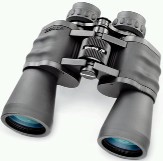Go for lower magnifications, e.g. 7x 8x or 10x.
7x or less are by far the the easiest to hold steady.
Anything 12x and above need a tripod or something to rest the binoculars on.
For daytime use in sunshine 30mm aperture upwards are fine. You can even use 20mm or 25mm compact binoculars in sunshine if they have good optics.
For general daytime use including less favourable lighting conditions, 40mm should be OK. These are also not so heavy!
For evening or low light use, 50mm aperture or bigger REALLY helps.
7 x 50 are usually a very good choice for slightly larger general purpose binoculars. This is the size used on boats and ships, with good reason. They often aren’t available in cheaper makes as they do show up optical problems more, given steadier brighter viewing.
A LOT depends on the quality of the optics. I can see more with good 6 x 35mm binoculars than average 10 x 50 binoculars.
Good optics give a brighter clearer and hence more detailed image to view. They also usually have better colour rendition use in lower light conditions.
Wide field binoculars give a pleasantly wide view, but do cost more.
Price is usually a very good guide to quality. Cheaper often means a flimsier and hence over-flexible body construction. When they distort, optical alignment goes out of the window!
Optical alignment called collimation is CRUCIAL. Look at e.g. a distant church spire with a wind vane on top. You should see ONE image. If there are two, the alignment is out, and the further apart the images are, the worse the alignment. REJECT binoculars that fail this test.
Multi-coated lenses (tinged blue/ green or blue/ purple) are best, but red coated lens are a fair substitute, if the binoculars are well made and have fairly decent optics.
ZOOM binoculars, except for EXPENSIVE models are a waste of time as they produce less bright images and a loss of sharper detail at the edge of view. You may also have to completely refocus (right eye adjustment as well) when the zoom is operated.
Good optics do make a LOT of difference.
A GOOD clue is the size of the eyepiece lenses. If they are too small, the binoculars will be difficult to use.
Basically, the HIGHER the magnification, more expensive optics are needed for a good image without distortion away from the field of view centre.
In reduced lighting, LOWER magnification gives a clearer image.
Good optics in binoculars are expensive, e.g. Minolta, Nikon, Zeiss, Leica, Opticron, Swarovski, etc but you do get what you pay for with these.
Some older makes have high quality optics, even if the lens coatings are weaker, e.g. Ross, and may be worth considering.
CHOOSE carefully, and you can get some quite reasonable binoculars fairly cheaply e.g. makes like Bushnell, Praktica, Bresser, Adler! |
|
